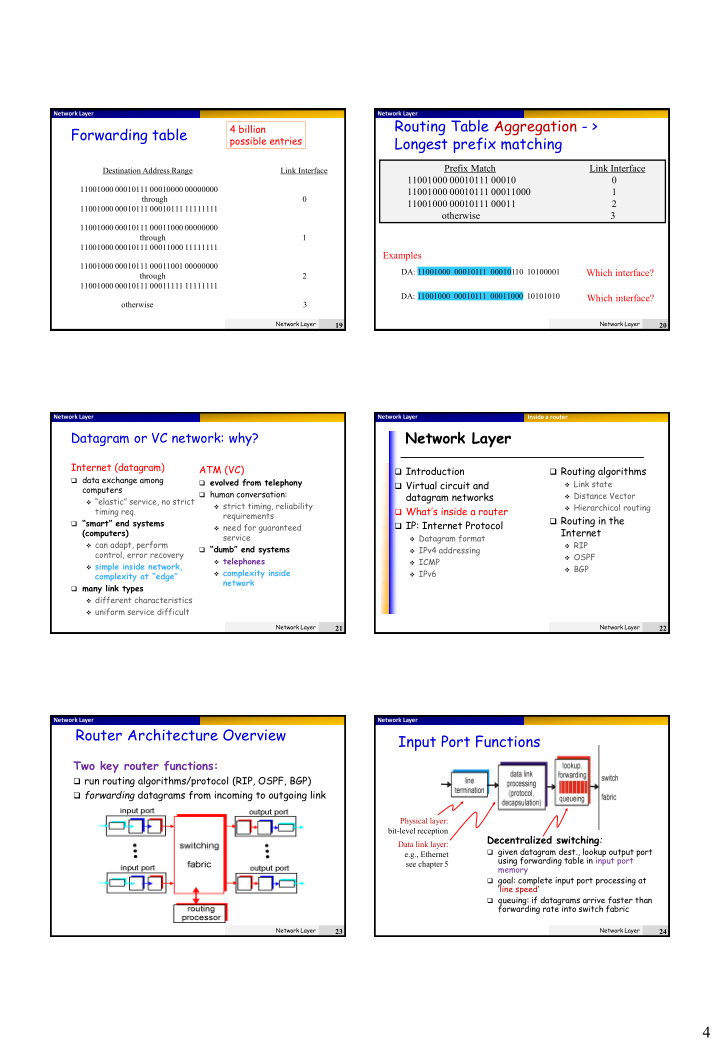



Network Layer Network Layer Network Layer Network Layer Routing Table Aggregation - > 4 billion Forwarding table Longest prefix matching possible entries Prefix Match Link Interface Destination Address Range Link Interface 11001000 00010111 00010 0 11001000 00010111 00010000 00000000 11001000 00010111 00011000 1 through 0 11001000 00010111 00011 2 11001000 00010111 00010111 11111111 otherwise 3 11001000 00010111 00011000 00000000 through 1 11001000 00010111 00011000 11111111 Examples 11001000 00010111 00011001 00000000 DA: 11001000 00010111 00010110 10100001 Which interface? through 2 11001000 00010111 00011111 11111111 DA: 11001000 00010111 00011000 10101010 Which interface? otherwise 3 Network Layer Network Layer 19 20 Network Layer Network Layer Network Layer Network Layer Inside a router Network Layer Datagram or VC network: why? Internet (datagram) ATM (VC) Introduction Routing algorithms data exchange among evolved from telephony Virtual circuit and Link state computers human conversation: Distance Vector datagram networks “elastic” service, no strict strict timing, reliability Hierarchical routing What’s inside a router timing req. requirements Routing in the “smart” end systems IP: Internet Protocol need for guaranteed Internet (computers) service Datagram format can adapt, perform RIP “dumb” end systems IPv4 addressing control, error recovery OSPF telephones ICMP simple inside network, BGP complexity inside IPv6 complexity at “edge” network many link types different characteristics uniform service difficult Network Layer Network Layer 21 22 Network Layer Network Layer Network Layer Network Layer Router Architecture Overview Input Port Functions Two key router functions: run routing algorithms/protocol (RIP, OSPF, BGP) forwarding datagrams from incoming to outgoing link Physical layer: bit-level reception Decentralized switching : Data link layer: given datagram dest., lookup output port e.g., Ethernet using forwarding table in input port see chapter 5 memory goal: complete input port processing at ‘ line speed ’ queuing: if datagrams arrive faster than forwarding rate into switch fabric Network Layer Network Layer 23 24 4
Network Layer Network Layer Network Layer Network Layer Switching Via Memory Three types of switching fabrics First generation routers: traditional computers with switching under direct control of CPU packet copied to system’s memory speed limited by memory bandwidth (2 bus ( 2 ) ( 1 ) crossings per datagram) Memory Input Output Port Port ( 3 ) System Bus Network Layer Network Layer 25 26 Network Layer Network Layer Network Layer Network Layer Switching Via An Interconnection Switching Via a Bus Network ( 印度 ) 榕树 Overcome bus bandwidth limitations datagram from input port memory Banyan networks, other to output port memory via a shared interconnection nets initially bus developed to connect processors in multiprocessor bus contention: switching speed limited by bus bandwidth Advanced design : fragmenting datagram into fixed length cells, 32 Gbps bus, Cisco 5600: sufficient switch cells through the fabric. speed for access and enterprise Cisco 12000 : switches 60 Gbps routers through the interconnection network Network Layer Network Layer 27 28 Network Layer Network Layer Network Layer Network Layer Examples of Output Ports Interconnection Networks Buffering required when datagrams arrive from fabric faster than the transmission rate Scheduling discipline chooses among queued datagrams for transmission Network Layer Network Layer 29 30 5
Network Layer Network Layer Network Layer Network Layer Input Port Queuing Output Port Queueing Fabric slower than input ports combined -> queueing may occur at input queues Head-of-the-Line (HOL) blocking: queued datagram at front of queue prevents others in queue from moving forward queueing delay and loss due to input buffer overflow! buffering when arrival rate via switch exceeds output line speed queueing (delay) and loss due to output port buffer overflow! Network Layer Network Layer 31 32 Network Layer Network Layer IP Protocol Network Layer Network Layer The Internet Network layer Network Layer Host, router network layer functions: Introduction Routing algorithms Virtual circuit and Link state Transport layer: TCP, UDP Distance Vector datagram networks IP protocol Hierarchical routing Routing protocols What’s inside a router • addressing conventions • path selection Routing in the • datagram format IP: Internet Protocol • RIP, OSPF, BGP Network • packet handling conventions Internet Datagram format layer forwarding RIP ICMP protocol IPv4 addressing table • error reporting OSPF ICMP •router “signaling” BGP IPv6 Link layer physical layer Network Layer Network Layer 33 34 Network Layer Network Layer Network Layer Network Layer IP datagram format Network Layer IP protocol version 32 bits total datagram number length (bytes) header length head. type of Introduction Routing algorithms ver length (bytes) len service for Virtual circuit and Link state “type” of data fragment fragmentation/ 16-bit identifier flgs offset reassembly datagram networks Distance Vector max number time to upper header remaining hops live layer Hierarchical routing checksum What’s inside a router (decremented at Routing in the 32 bit source IP address each router) IP: Internet Protocol Internet 32 bit destination IP address Datagram format upper layer protocol RIP to deliver payload to E.g. timestamp, IPv4 addressing Options (if any) OSPF record route ICMP how much overhead data taken, specify BGP (variable length, with TCP? list of routers IPv6 typically a TCP to visit. 20 bytes of TCP or UDP segment) 20 bytes of IP = 40 bytes + app layer overhead Network Layer Network Layer 35 36 6
Recommend
More recommend